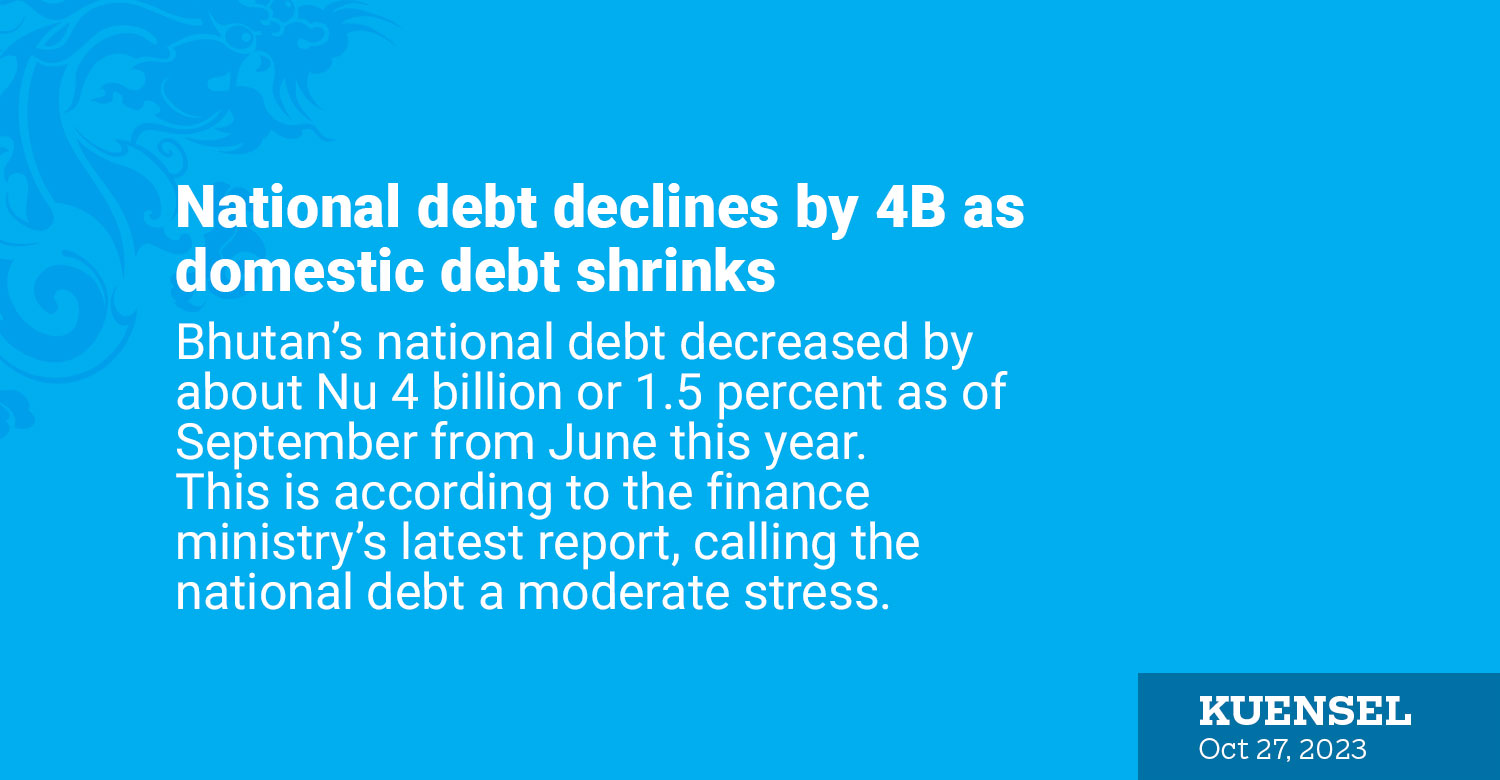Thukten Zangpo
Bhutan’s national debt decreased by about Nu 4 billion or 1.5 percent as of September from June this year.
This is according to the finance ministry’s latest report, calling the national debt a moderate stress.
Despite national debt reaching at Nu 272.97 billion, equivalent to 134.8 percent of the gross domestic product (GDP), the ministry stated that the overall risk is deemed manageable.
It came down from Nu 276.98 billion or 136.8 percent of GDP in June this year.
This decrease was mainly because of about 20 percent or Nu 6.69 billion decline in domestic debt.
As of September, the domestic debt stood at Nu 26.1 billion—Nu 7.3 billion treasury bills and Nu 18.8 billion government bonds.
Domestic debt decreased because of improvement in domestic revenue inflows and settlement of ways and mean advances (WMA) and overdraft facility, according to the finance ministry.
Conversely, the external debt saw an increase by Nu 2.68 billion to Nu 246.87 billion as of September.
External debt is owed by the government, corporations, and the central bank.
Despite seeing a decrease in the external debt denominated in INR by Nu 1.46 billion on account of repayment of Mangdechhu and Nikachhu loans, there was Nu 4.14 billion increase in the convertible currency (CC) debt.
The World Bank’s budgetary support loan amounting to USD 50.2 million or Nu 4.13 billion for Bhutan Second and Resilient Growth Policy Credit in August 2023 increased the CC-debt.
As of September, the CC-debt was reported at Nu 84.03 billion or USD 1.02 billion. This was 35.7 percent of the total external debt.
Government debt, accounting 92 percent of the total external debt (borrowings for budgetary activities, hydropower projects, and loans availed by the government on-lent to public corporations) was recorded at Nu 227.03 billion.
At the same time, the corporate debt, borrowed by the public corporations, 5.2 percent of the total external debt, was recorded at Nu 12.83 billion.
The central bank had Nu 7 billion debt which was borrowed as a standby credit facility from the Indian government.
Hydro-debt of six hydropower projects of Mangdechhu, Puna-I, Puna-II, Nikachhu, Dagachhu, and Basochhu stood at Nu 167.1 billion (67.7 percent of external debt) as of September this year.
INR-denominated hydropower debt accounted for Nu 158.7 billion or 66.1 percent of total external debt.
On the other hand, non-hydro debt is reported at Nu 79.77 billion, which is 32.3 percent of external debt or 39.4 percent of GDP.
According to the finance ministry, the debt service as a percentage of government revenue is estimated at 32.4 percent for this fiscal year 2023-24, which is within the threshold of 35 percent in the Public Debt Management Policy 2023.
The non-hydro budgetary debt is at Nu 90.6 billion, constituting 33.2 percent of total public debt and 44.8 percent of estimated GDP. This is within the threshold of 55 percent of GDP annually as per the Public Debt Management Policy 2023.
The non-budgetary debt refers to the central government debt where all the liabilities fall directly to the government.
The external debt service to exports ratio is estimated at 16.8 percent in this fiscal year 2023-24.
India remains Bhutan’s largest creditor with 63 percent of the external debt, followed by 16 percent from Asian Development Bank, and 15 percent from the International Development Association, among others.


